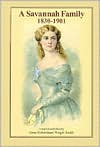

 |

|

The average rating for A Savannah Family, 1830-1901: Papers from the Clermont Huger Lee Collection based on 2 reviews is 4.5 stars.
Review # 1 was written on 2012-09-17 00:00:00 William Kuhn William KuhnCrook has long been a respected historical figure, someone important to my perception of history. Didn't find this informative book compelling, but do recommend it for the subject matter. *** 3/23/19 - Curious about location of Fort Omaha relative to flooding .... Ran across article where Crook was featured quote from wiki about Standing Bear : " ... Native American civil rights leader who successfully argued in U.S. District Court in 1879 in Omaha that Native Americans are "persons within the meaning of the law" and have the right of habeas corpus, thus becoming the first Native American judicially granted civil rights under American law. His wife Susette Primeau (Primo), daughter of Lone Chief/Antoine Primeau, was also a signatory on the 1879 writ that initiated the famous court case. " "Brigadier General George Crook had the Ponca arrested for having left the reservation in Indian Territory.[8] The Army took Standing Bear and the others to Fort Omaha, where they were detained. Although the official orders were to return them immediately to Indian Territory, Crook was sympathetic to the Ponca and appalled to learn of the conditions they had left. He delayed their return so the Ponca could rest, regain their health, and seek legal redress." *** Here's a review from HistoryNet.com "Geronimo and General Crook were born to destroy each other." With that note, Peter Aleshire begins his paired biography of two of the most famous participants in the Indian wars. Geronimo, born into the Bedonkohe band of the Chiricahua Apaches, and Ohio-born Crook were archenemies who embodied the strengths and weaknesses of their respective cultures. In chronicling these "perfect" enemies, The Fox and the Whirlwind also says a lot about the irreconcilable struggle between Indians and whites. A shaman and a merciless warrior, but never a "chief," Geronimo sought revenge with a passion and became, according to Aleshire, "the white man's most hated foe and a romanticized symbol of Indian resistance." Crook, on the other hand, could relate to-and even admire-the Indian lifestyle more than most of his fellow officers, but his understanding of the natives did not keep him from working hard to destroy their cultures and grab their land. He was a gifted cavalry commander who proved his capabilities in the Civil War and then played a prominent role in both the Sioux and Apache wars. In the Battle of the Rosebud in Montana Territory on June 17, 1876, Crook fought a large force of Sioux (including Crazy Horse) and Cheyenne warriors in an intense fight that produced relatively few casualties and no clear-cut victor. "Crook stubbornly claimed victory at the Rosebud for the rest of his life," writes Aleshire, even though the Rosebud fight had knocked Crook out of the so-called Little Bighorn campaign. Against Geronimo in the Southwest and Mexico, there would be hard-fought campaigns without any big battles (Geronimo did not have the forces for a Rosebud like engagement). In March 1886, Crook obtained the surrender of the elusive Chiricahua. The general's success was short-lived, though, as Geronimo again slipped away. Crook had been, according to Aleshire, "defeated by a warrior no less determined, fighting in a hopeless cause," and General Nelson A. Miles would get credit for Geronimo's final surrender that September. The author suggests that Crook "probably had more in common temperamentally and ethically with Crazy Horse and Geronimo than he had with the politicians and bureaucrats and politically minded generals…." Aleshire uses two distinct voices as he alternates between Geronimo chapters and Crook chapters. The author relies on numerous firsthand accounts, records and reports to tell Crook's well-documented tale in conventional fashion. For Geronimo's side of the story he adopts a narrative voice (avoiding direct quotes, accepting Geronimo's claim to supernatural powers, etc.) that he says was "inspired by the tone of Mari Sandoz's brilliant biography of Crazy Horse." If nothing else, this "switching" tactic emphasizes the chasm between the cultures of these two fighting men. By the way, they did not end up destroying each other." ** For another look General Crook and the Apaches, "Watch For Me On the Mountains" is well written, and one of my longtime multiple reread HF-USA favorites. Watch for Me on the Mountain Crazy Horse: The Strange Man of the Oglalas |
Review # 2 was written on 2018-12-06 00:00:00 Richard Tarrant Richard TarrantThis is an interesting read. It presents Geronimo and his beliefs in a respectful way, and gives a realistic view of George Crook's (not always fair, but sympathetic) opinions on the Apaches, and indigenous tribes in general. The story of the antagonism between the two, and of Geronimo's surrender, is well described. And for me, it was nice to learn a few details of Crook's personal life. Worthwhile |
CAN'T FIND WHAT YOU'RE LOOKING FOR? CLICK HERE!!!